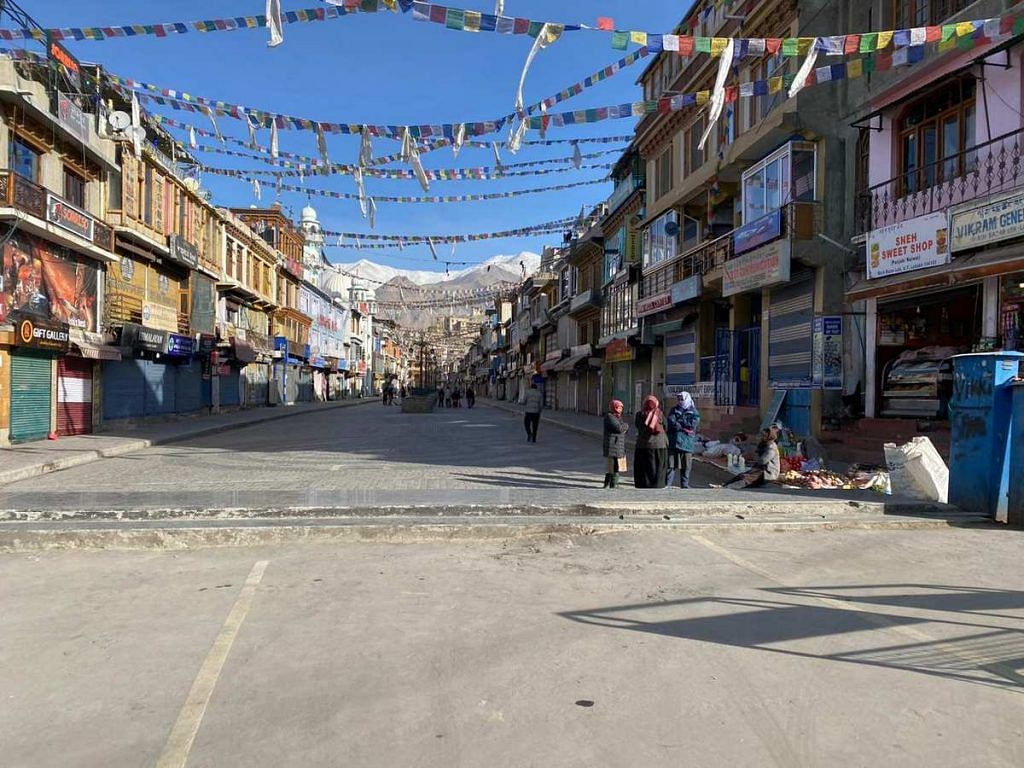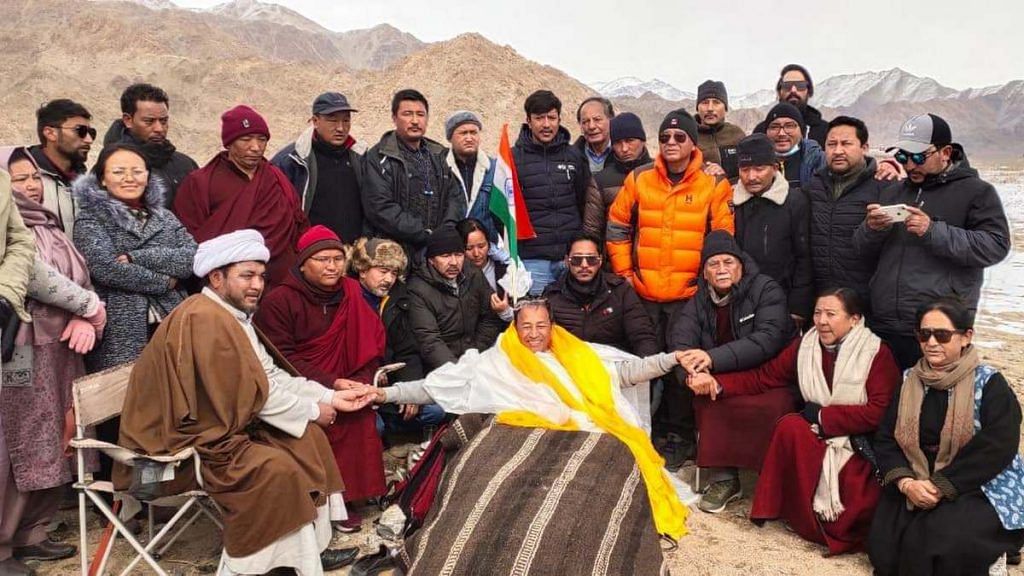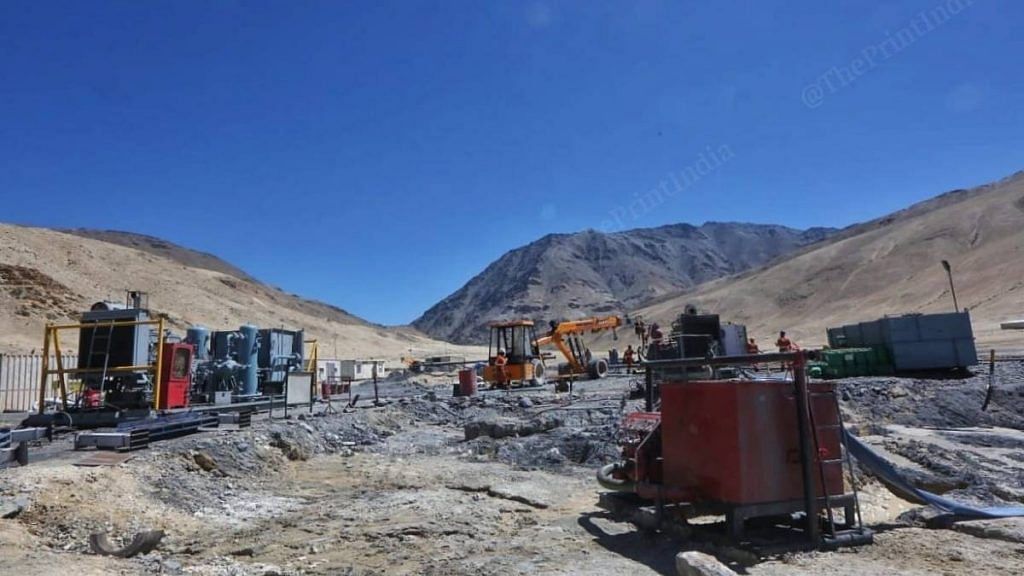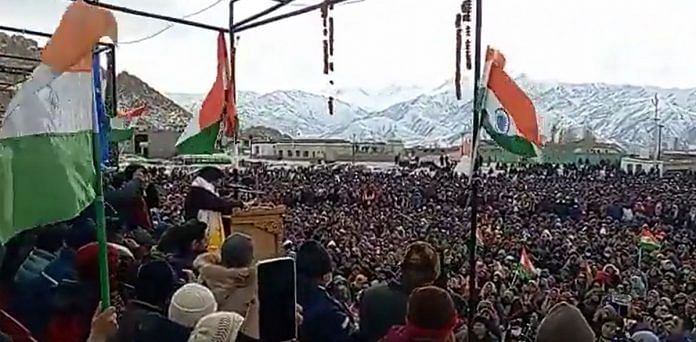Leh: Joyous cries of “freedom” had rippled across Leh’s mountain air in August 2019 when the Modi government carved Ladakh out into a Union territory from the erstwhile state of Jammu and Kashmir. But today, many of the same voices are rising in protest.
They say ‘freedom’ from J&K has come at the cost of the special status which the nullified Article 370 had granted, and there’s now a fight to protect the region’s identity, land, environment, and autonomy.
The most prominent face of the agitation is Sonam Wangchuk, the engineer, education reformer, and Magsaysay Award winner who first shot to national fame as the inspiration for Aamir Khan’s character in the 2009 film 3 Idiots. Last month he concluded a five-day ‘Save Ladakh’ hunger strike that he had begun on 26 January, garnering support from thousands of people in Ladakh and beyond.
Back in 2019, though, Wangchuk had tweeted his gratitude to Prime Minister Narendra Modi for “fulfilling Ladakh’s longstanding dream” of becoming a Union territory. “Thank you”, he had said, to all who helped bring about “democratic decentralisation”.
THANK YOU PRIME MINISTER
Ladakh thanks @narendramodi @PMOIndia
for fulfilling Ladakh's longstanding dream.
It was exactly 30 years ago in August 1989 that Ladakhi leaders launched a movement for UT status. Thank you all who helped in this democratic decentralization! 🙏🙏🙏 pic.twitter.com/X7pmJ5zZin
— Sonam Wangchuk (@Wangchuk66) August 5, 2019
But anger has now replaced gratitude.
Wangchuk, like many others here, believes that the Union government has not delivered on the “dream” that it had promised, instead leaving Ladakh at the mercy of ‘outside’ authorities who lack a complete understanding of the region’s needs and vulnerabilities. Further, there is widespread dissatisfaction with the lack of jobs and political representation.
When ThePrint Wednesday visited Wangchuk’s mud-and-wood home, situated amid barren hills, he seemed calm but determined. The fast is over, but the fight to protect Ladakh’s ecology and self-determination is not, he said.
“We are not asking for anything illegal. We are asking for what the government had promised us but is now ignoring,” he said.
At the core of the battle is a demand to include Ladakh under the Sixth Schedule, which provides for the administration of certain tribal areas by autonomous district councils that also have powers to make laws in areas like land and forests, among others.
The purpose of this provision, which comes under Article 244 of the Constitution, is to safeguard the interests and culture of tribal populations while also providing for their development.
Wangchuk explained that without the Sixth Schedule, Ladakh’s fragile ecology could be severely impacted by an influx of industries.
“We are already telling the government that Ladakh is not like the rest of the country. It is different. Even when tourists come here, the burden increases. If a big industry comes, Ladakh will not be able to bear it and that is why we are demanding Schedule Six,” he said.

He also claimed that budgetary allocations for Ladakh were not being spent properly. “The Lieutenant Governor and bureaucrats come here for two-three years and by the time they understand the place, it’s time to leave. They don’t know how to spend the budget,” he said.
Wangchuk is not the only voice raising such issues. Since 2021, two umbrella outfits called the Leh Apex Body (LAB) and Kargil Democratic Alliance (KDA) have been consistently demanding more safeguards and autonomy for Ladakh. The two bodies — which comprise political and religious leaders, union workers, as well as youth and women outfits — even staged a large protest in Jammu last month.
“We have four demands which we have been raising for a long time — statehood, constitutional safeguards under the Sixth Schedule, separate Lok Sabha seats for Leh and Kargil districts, and job reservation for locals,” Sajjad Kargili, a member of the KDA, told The Print. “These are not our demands but those of everyone in Ladakh.”
Also read: ‘Ladakh has been forgotten’: Sonam Wangchuk’s climate fast adds heft to calls for 6th Schedule
‘Benefits have gone away’
The granting of UT status to Ladakh was a wish come true for many. The expectation was it would boost access to government funds and resources, improve administration, and lead to better representation in Parliament — along the lines of Puducherry and Delhi, which are UTs with legislative assemblies.
However, ever since it officially became a UT in October 2019, Ladakh, like J&K, has been governed by the central government through a Lieutenant Governor and there is no legislative assembly.
Tsering Dorjey Lakrook, vice-chairman of the Ladakh Buddhist Association, which is part of the agitation, said that he had been glad about Ladakh’s UT status at first, but has since become disillusioned.
“We have been struggling for three years. What we thought did not happen. We were asking for UT plus legislature but we got UT without legislature. Due to this, the benefits that we used to get earlier (under Article 370) have gone away, including land security and jobs,” he said.
Locals say that before separation from J&K, their land and culture were at least safe. Now, they say, anyone can come to their land, start a project and use their resources.
“Right now, almost 3 lakh people live in Ladakh with limited resources, but if there is a big project and hundreds of people start coming, we can’t do anything about that. At least, before separation, our land was secure,” said local resident Mohmmad Faruq.
Faruq was on a stroll in Leh’s main market on Mall Road, where jagged white mountains form a scenic backdrop. Women vendors were busy selling vegetables and fruits on the footpath, but it’s not tourist season, so many shops were closed.

Riyaz Ahmed, 74, runs one of the few shops that are still open. He was also among those who celebrated when Ladakh became a Union territory, but his feelings, too, have changed, he said.
“Ladakh’s border is connected with both China and Pakistan. We are soldiers without uniforms. We are ready to serve the country with body, mind, and money. We just want the government to provide us security through the Sixth Schedule so that our land and culture are safe. The whole of India is like a family and Ladakh is the watchman of this family,” he said, adding that his father was a freedom fighter. “We want the government to give us what we are entitled to.”
Demand for Sixth Schedule, ‘forgotten promises’
Ladakh currently has two elected councils, but they have limited powers over local administration. One body is the BJP-led Ladakh Autonomous Hill Development Council (Leh) and the other is the National Conference-led Ladakh Autonomous Hill Development Council (Kargil). Each of the two LAHDCs has 30 councillors.
With the revocation of Article 370, the LAHDCs have even fewer meaningful powers owing to the overriding authority of the Lieutenant Governor.
These bodies do not come under the Sixth Schedule, which bestows some legislative, judicial, and administrative powers to district councils. This provision currently extends only to predominantly tribal areas in some Northeastern states, including Mizoram, Meghalaya, Assam, and Tripura.
Notably, in September 2019, the National Commission for Scheduled Tribes (NCST) had written to the government, recommending the inclusion of Ladakh under the Sixth Schedule.

The commission had pointed out that “the total tribal population in Ladakh region is more than 97 per cent”. It also said that including it under the Sixth Schedule would allow for “democratic devolution of powers”, preserve the region’s culture, protect land rights, and “enhance transfer of funds for speedy development”.
Subsequently, in 2020, Union minister Anurag Thakur had asserted that the central government was “committed” to extending the Sixth Schedule to Ladakh to preserve the land, culture, and “unique identity” of the people. Since then, though, the government has remained non-committal on the issue, leading to growing discontent in the region.
There is anger that the people of Ladakh still lack representation and have little say in policy-making, which is now largely in the hands of government officials. Many also believe that the situation was better when Article 370 was in place, since it provided some safeguards for their land.
Last year, both hill development councils, too, passed separate resolutions seeking Sixth Schedule-like status for Ladakh.
Climate threat, job woes
With melting glaciers leading to a water crisis and shrinking grazing lands putting livelihoods in danger, Ladakh is already suffering the impact of climate change.
Activists fear that things could get a lot worse if there is no way for the people to safeguard their land or have a say in how development takes shape and budgetary outlays are spent.
“No one talks about it. Glaciers that were there 20 years ago do not exist anymore. They are melting very fast but all we do is politics,” said Stanzin Chosphel, youth coordinator of the Leh Apex Body.
“A solar power project came to Ladakh. Who took the decision? Not our people. If Ladakh comes under the ambit of the Sixth Schedule, then we will know where to set up such projects so that the environment is not harmed,” said Lakrook of the Ladakh Buddhist Association.

Another major problem in Ladakh is unemployment. Most people are dependent on the government for employment because there are few opportunities in the private sector or in industries.
“Ladakh is among those states in the country where the unemployment rate is the highest. The youth are dependent on the government for jobs. We were expecting jobs after becoming a UT. But there is not even one posting on the gazette level,” said Tundup Thinlas, president of a local organisation called the All Ladakh Unemployment Youth Association (ALUYA).
“We live on minimum resources, we deserve at least job security in our region,” he added.
As of now, Ladakh does not have a recruitment body for government jobs. One of the demands of the Leh Apex Body and KDA is to establish a public service commission for Ladakh.
‘Bureaucracy is running everything’
An oft-repeated complaint in Ladakh is that civil servants have been tasked with making crucial decisions for Ladakh and for spending the majority of the allocated budget.
“Now we are only under bureaucrats. We get an amount of around Rs 6,000 crore. The Leh and Kargil councils get only Rs 500 crore and the bureaucrats decide where the rest of the money is to be spent,” Lakrook claimed.
Wangchuk, too, has made the same allegation multiple times.
“The central government gave us Rs 6,000 crore, but they couldn’t decide where to spend it. It got lapsed because they don’t know what to do with that money for Ladakhi people,” he told ThePrint.
The Union government had announced an allocation of Rs 5,958 crore for Ladakh for the fiscal 2020-21. The same amount was also announced for 2022-23 and 2023-24.
Sajjad Karigili of the KDA further alleged that “bureaucrats are running Ladakh” and even bypass the hill councils on administrative and other matters.
When asked about these allegations, Ladakh divisional commissioner Saugat Biswas said that it was “wrong to say that bureaucrats act arbitrarily” and that efforts were made to involve the people in decision-making.
“The people of Ladakh are consulted in all the rural development works we do. Proposals come from the gram panchayats, block development councils, and councillors of the LAHDCs. Suppose there is a requirement for augmenting electricity facilities in a village, then the same feedback comes from the people to the Power Development Department. Or, if there is no telephone tower, then the feedback comes from the people to the concerned department where it is addressed,” Biswas said.
“Requirement of various infrastructure and facilities come from the people. The administration has also financially empowered the elected block development councils and panchayats by allocating funds for both capex and revenue expenditure,” he added.
Where does the impasse stand?
Last month, the Ministry of Home Affairs (MHA) constituted a 17-member committee to “discuss measures to protect the region’s unique culture and language taking into consideration its geographical location and its strategic importance”.
While the two LAHDCs reportedly “welcomed” the move, the Leh Apex Body and Kargil Democratic Alliance are not impressed.
“We were not satisfied with the composition of this committee. They offered ‘constitutional safeguards’ and we want the Sixth Schedule. It is this that will give the law-making power to the council,” said Thupstan Chhewang, ex-MP and a member of the Leh Apex Body.
“When there is a provision of the Sixth Schedule in the Constitution for the tribal population, then why is there talk of giving us another safeguard?” he asked. “We have written a letter to the Ministry of Home Affairs and told them about our problems and now we are waiting for their reply.”
(Edited by Asavari Singh)
Also read: Between China, climate change & development, Ladakhi nomads are losing grip on their land



